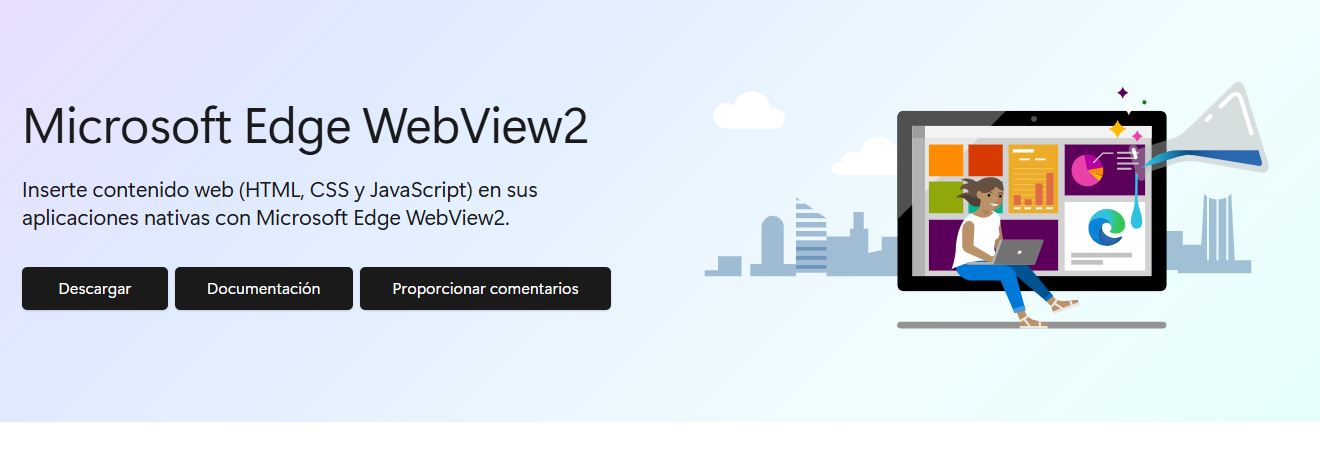- WebView2 is key to modern Microsoft 365 features and .NET apps.
- Repair may fail; clean reinstallation usually resolves it
- Office can automatically reinstall the runtime if it detects it is missing
- Evergreen Installer and running as administrator guarantee success

Reinstall Edge WebView2 It can be a real pain when the "Repair" option doesn't work or Windows only shows "Change/Modify" in Programs and Features. In some cases, even running advanced uninstall commands can't get it to disappear from the system, and it ends up reappearing.
Before we get down to business, it is important to understand that WebView2 es the runtime used by desktop applications to display web content, including some modern Microsoft 365 features (Outlook, add-ins, etc.). So, even if you manage to remove it, Office or other apps can automatically reinstall it. In this guide, you'll see exactly what it is, why it returns, how to check if it's installed, how to update it, and reliable steps to cleanly uninstall and reinstall it when a repair fails.
What is Microsoft Edge WebView2 and why is it on your PC?
WebView2 is a component that Take advantage of the Microsoft Edge (Chromium) engine to render web content within desktop applications. Outlook, Office add-ins, and many .NET apps display consistent web interfaces on Windows without relying on the user's browser.
Microsoft started to WebView2 Runtime to be released in April 2021 to Windows computers running Microsoft 365 Apps version 2101 or later. If it was already installed, it's automatically updated to the latest version. That's why many people see it appear without having requested it: it's required to support modern features in Office and other applications.

Which functions depend on WebView2
In Microsoft 365, Outlook uses WebView2 for features like Room Finder and Meeting InsightsAdditionally, Office add-ins are increasingly relying on this runtime. Without WebView2, these features may not display or fail to load.
Using WebView2 makes sense because unifies the visual experience across platformsWhat you see in Windows is aligned with what you see on the web. For developers, integrating WebView2 is simple and compatible with modern web technologies (HTML, CSS, JavaScript). Hence the importance of reinstalling Edge WebView2 when it starts to fail.
Advantages and resource consumption
Among the benefits, it stands out that it is light and focused on what is necessary (It's not a full browser), it's cross-platform across web technologies, and it doesn't depend on the user having Edge open. It's common to see multiple instances in Task Manager under the name "Microsoft Edge WebView2" within the Outlook process.
In terms of consumption, the processes usually mark very low CPU, disk, network and GPU usage, and modest RAM consumption (a few MB per process). It shouldn't affect the performance of current computers, and in practice, it remains fairly low even on older PCs.
How to install WebView2 Runtime
To reinstall Edge WebView2, you must first know how to install it for the first time. By default, does not come pre-installed with Windows. It is installed on demand by Office or other apps that require it. If you want to install it manually, you can download the official bootstrapper using PowerShell:
Invoke-WebRequest -Uri "https://go.microsoft.com/fwlink/p/?LinkId=2124703" -OutFile "WebView2Setup.exe"Another option is to go to the official WebView2 page and use the Evergreen Bootstrapper or the Evergreen Standalone (offline) at your convenience. The standalone installer is useful if you're reinstalling on multiple computers or don't have an internet connection.

Check if it is installed and locate its folder
To verify the installation, go to Configuración > Aplicaciones and search for "Microsoft Edge WebView2 Runtime." You can also confirm this by exploring its default path:
C:\Program Files (x86)\Microsoft\EdgeWebView\ApplicationInside you will see a subfolder with the version number. Shares base version with Edge in many cases, but it runs independently, so it will continue to run even if you uninstall or stop using the browser.
WebView2 updates itself, Sometimes in the month, with differential packages of approximately 5 MB to 30 MB. It may also occasionally receive updates through Windows Update, so you usually won't need to intervene.
These updates are intended to improve safety and reliability of the apps that use it. If you manage fleets, you can control deployment from your organization's management tools. Caution: Updating is not the same as reinstalling Edge WebView2.
Uninstalling via commands (and why it sometimes doesn't work)
A common method is to go to the installer folder and run setup.exe with arguments to uninstall at the system level. For example:
- Open Command Prompt as administrator. It is essential to elevate privileges to avoid permission errors.
- Navigate to the installer folder (change “1*” to your version subfolder if necessary):
cd C:\Program Files (x86)\Microsoft\EdgeWebView\Application\1*\Installer - Ejecutar el forced silent uninstaller:
.\setup.exe --uninstall --msedgewebview --system-level --verbose-logging --force-uninstall
On some computers, after running these commands, it seems that nothing happens because another app (often Microsoft 365 Apps) is bringing up the runtime again. If this is the case, consider temporarily disabling automatic installation from the Microsoft 365 admin portal before proceeding with a clean reinstall.
Uninstall from Settings or Control Panel
You can also try from Configuración > Aplicaciones, selecting "Microsoft Edge WebView2 Runtime" and then "Uninstall." In the Control Panel, go to Programs and Features, search for "Microsoft Edge WebView2 Runtime," right-click, and then "Uninstall."
If the system only allows "Change/Modify", try the method of setup.exe with parameters indicated above, or use a third-party uninstaller that cleans file and registry residues (Revo Uninstaller, IObit Uninstaller or HiBit Uninstaller).
Clean reinstall when "Repair" doesn't work
If the "Repair" option does not solve the problem, you can follow a clean reinstallationTo reinstall Edge WebView2, follow these steps:
- (Optional in environments with Microsoft 365) In the admin center, temporarily disables automatic installation of WebView2 so that it does not reinstall itself during the process.
- Close Outlook and any apps that may be running. using WebView2This reduces crashes during uninstallation.
- Uninstall from Settings/Control Panel or with the command del setup.exe at the system level.
- Restart Windows to ensure that files in use are released and the removal is complete.
- Download the official installer. If you want the standalone (offline) installer, go to the WebView2 page and choose your architecture (x86, x64, or ARM64). Alternatively, use the bootstrapper:
Invoke-WebRequest -Uri "https://go.microsoft.com/fwlink/p/?LinkId=2124703" -OutFile "WebView2Setup.exe" - Install by running the file as Administrator (Right-click > Run as administrator). Follow the wizard until finished.
- Check in Settings > Applications that “Microsoft Edge WebView2 Runtime” appears and check its folder and version in “Application”.
- (Managed Environments) If you disabled it, please turn it back on. enable automatic installation of WebView2 in the admin center.
Install and run as administrator: detailed steps
After downloading the official installer, it is recommended run it with elevated privileges To ensure that you type correctly into the system:
- Locate the installation file on your computer and do right-click sobre él.
- Select "Run as administrator" and confirm the UAC if requested.
- Follow the wizard's instructions until finished, unclosed if a long progress window appears.
- Check the result in Settings > Apps or in the carpeta de instalación.
Should You Delete It? Pros and Cons
From a practical point of view, There is no reason to remove WebView2 If you use Office or apps that require it. Uninstalling it may break features like Room Finder or some add-ins.
The only clear advantage of uninstalling is free up some space and RAM (around 475 MB on disk and tens of MB in idle memory). On very limited machines, this might make sense, but you'll be left without runtime-dependent features.
If your computer is doing worse than "last time": consider updating or reverting
If you've been experiencing performance issues for a few days, the source may be a recent Windows update and not WebView2. To test this, go to Windows Update > View installed updates, note down the KB code, select "Uninstall updates," and uninstall it.
Reboot and check if performance improvesIf not, consider other measures (system restore or clean reinstall of Windows) if the problem persists without relation to WebView2.
How to avoid unwanted reinstallations in companies
If you manage devices and want to control when the runtime appears, use the Microsoft 365 admin center (config.office.com) to postpone the automatic installation. This way, you can deploy the correct version via Evergreen Standalone when the time comes.
Remember that other third-party apps can also install WebView2Even if you block it from your Microsoft 365 settings, an app that relies on it could reintroduce it.
Troubleshooting typical errors with WebView2
Si te aparece el mensaje "There is a problem with WebView2" When opening an app (e.g., Edge or Outlook), try the clean uninstall and reinstall cycle described above. It's not a widespread issue, but it can occur in certain configurations.
When repair doesn't fix anything, remove and restart the runtime It usually resolves corrupted files or conflicting versions. Make sure to close the affected apps and run the installer as an administrator.
If you need to remove and reinstall it, follow the steps carefully and with administrator permissions, avoiding closing critical processes and taking into account that Office can automatically reinstall it if it detects that it is missing.
Editor specialized in technology and internet issues with more than ten years of experience in different digital media. I have worked as an editor and content creator for e-commerce, communication, online marketing and advertising companies. I have also written on economics, finance and other sectors websites. My work is also my passion. Now, through my articles in Tecnobits, I try to explore all the news and new opportunities that the world of technology offers us every day to improve our lives.